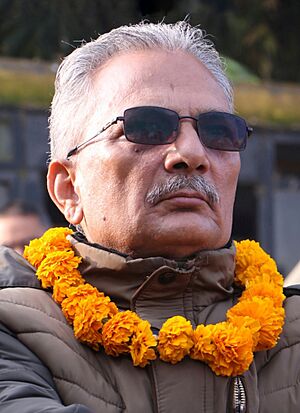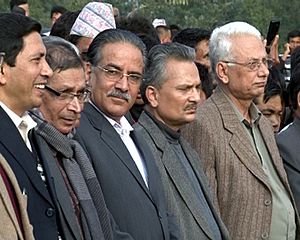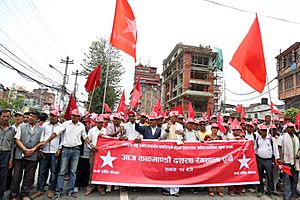Baburam Bhattarai facts for kids
Quick facts for kids
Baburam Bhattarai
|
|
|---|---|
|
बाबुराम भट्टराई
|
|

Bhattarai in 2017
|
|
| 36th Prime Minister of Nepal | |
| In office 29 August 2011 – 14 March 2013 |
|
| President | Ram Baran Yadav |
| Deputy | Bijaya Kumar Gachchhadar Narayan Kaji Shrestha Krishna Prasad Sitaula (6 – 29 May 2012) Ishwar Pokhrel (16 – 29 May 2012) |
| Preceded by | Jhala Nath Khanal |
| Succeeded by | Khil Raj Regmi |
| Minister of Finance | |
| In office 18 August 2008 – 25 May 2009 |
|
| President | Ram Baran Yadav |
| Prime Minister | Pushpa Kamal Dahal |
| Chairman of Nepal Socialist Party | |
| Assumed office 28 July 2022 |
|
| Preceded by | Position established |
| Member of Parliament, Pratinidhi Sabha | |
| In office 4 March 2018 – 18 September 2022 |
|
| Preceded by | Hari Raj Adhikari |
| Succeeded by | Pushpa Kamal Dahal |
| Constituency | Gorkha 2 |
| Member of Constituent Assembly | |
| In office 28 May 2008 – 28 May 2012 |
|
| Preceded by | Parbati Thapa Shrestha |
| Succeeded by | Hari Raj Adhikari |
| Constituency | Gorkha 2 |
| In office 21 January 2014 – 26 September 2015 |
|
| Preceded by | Kamala Panta |
| Succeeded by | Hit Raj Pandey |
| Constituency | Gorkha 1 |
| Personal details | |
| Born | 18 June 1954 Khoplang, Nepal |
| Political party | Nepal Socialist Party |
| Other political affiliations |
CPN (Fourth Convention) Samyukta Janamorcha UCPN (Maoist) (before 2015) Naya Shakti (2016-2019) |
| Spouse |
Hisila Yami (m. 1980)
|
| Children | 1 |
| Parents |
|
| Education | Amrit Science College, Tribhuvan University Chandigarh College of Architecture (B.Arch.) SPA New Delhi (M.Tech.) Jawaharlal Nehru University (PhD) |
Baburam Bhattarai (born on June 18, 1954) is a well-known Nepalese politician and architect. He once served as the Prime Minister of Nepal. Today, he leads the Nepal Socialist Party.
Before starting his own party, Naya Shakti Party, Nepal, Bhattarai was a key member and deputy leader of the Unified Communist Party of Nepal (Maoist). He later became a supporter of democratic socialism, which is a political idea that combines democracy with social fairness.
Contents
Baburam Bhattarai's Political Journey
Bhattarai's political journey began with big changes in Nepal. In 1996, a group called the Maoists started a civil war. This conflict lasted for ten years and led to Nepal changing from a kingdom (monarchy) to a republic. A republic is a country where the people elect their leaders, instead of having a king or queen.
In 2008, Bhattarai was chosen to be part of the Nepalese Constituent Assembly. This group was formed to write a new constitution for Nepal. After being elected, he became the Minister of Finance, in charge of the country's money matters.
Becoming Prime Minister
In 2011, Baburam Bhattarai became the 36th Prime Minister of Nepal. He served in this important role from August 29, 2011, to March 14, 2013. During his time as Prime Minister, he worked on important projects, like expanding the ring road around the capital city.
After his term, he was replaced by Chief Justice Khil Raj Regmi. This was done to help solve a political problem and prepare for new elections.
The Maoist Movement
On February 4, 1996, Bhattarai presented a list of 40 demands to the government. These demands focused on making Nepal stronger and fairer. They included ending foreign control over Nepali businesses and sharing land more equally. The Maoists began their armed movement before the government could respond to these demands.
Later, the 40 demands were shortened to 24 during political talks. There were some disagreements between Bhattarai and another Maoist leader, Prachanda, about sharing power. However, they later worked out some of their differences.
In November 2005, Prachanda and a group of seven political parties made an agreement. They stated that the king's rule was stopping Nepal from moving forward. They also promised to respect human rights, press freedom, and a multi-party system, where many different political parties can exist.
Stopping the Conflict: Ceasefires
During the civil war, there were times when both sides agreed to stop fighting. These agreements are called ceasefires. One important ceasefire happened on April 26, 2006. This followed huge protests across Nepal that made King Gyanendra give up his power and bring back the parliament.
After this, a new government was formed. Both the parliament and the new government supported the ceasefire. They started talking with the Maoists to find a peaceful way forward. They agreed that a new assembly would be elected to write a new constitution. This process aimed to decide Nepal's future, with the Maoists hoping for Nepal to become a republic.
Starting a New Party: Naya Shakti
On July 12, 2016, Baburam Bhattarai announced the creation of a new political party called Naya Shakti Nepal, which means "New Force Nepal." He had planned this new political group since January of that year. Many leaders from other parties attended the ceremony where he announced his new party.
He briefly joined an alliance with other parties but later left because he was not guaranteed a chance to run in the elections.
Baburam Bhattarai's Personal Life
Baburam Bhattarai was born in a village called Khoplang in Gorkha, Nepal. He grew up in a family that worked on a farm and was not very wealthy. He has three siblings: two sisters and one brother. He belongs to the Brahmin group in Nepal.
He finished his high school education at Amar Jyoti High School in Gorkha. He then went to Amrit Science College for further studies. After that, he received a scholarship to study architecture in Chandigarh, India, in 1977. His former principal described him as an "outstanding student." During this time, he also helped start the All India Nepalese Student's Association.
Bhattarai continued his studies, earning a master's degree in planning and architecture. He is married to Hisila Yami, who is also a Maoist leader. They have one daughter named Manushi. He completed his PhD degree in 1986. His research focused on understanding why Nepal was underdeveloped.
See also
 In Spanish: Baburam Bhattarai para niños
In Spanish: Baburam Bhattarai para niños
- Nepal Socialist Party



